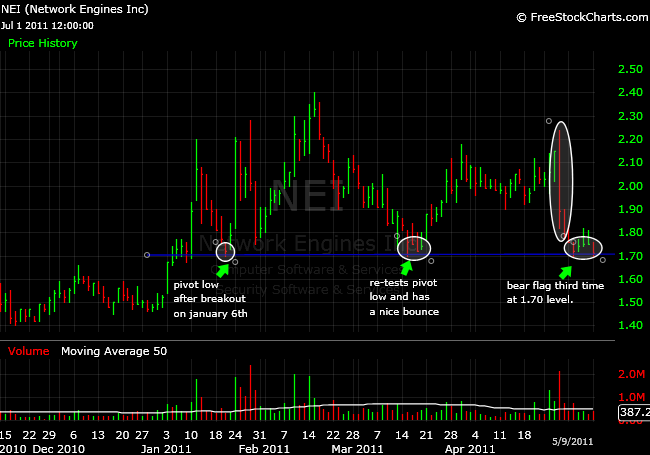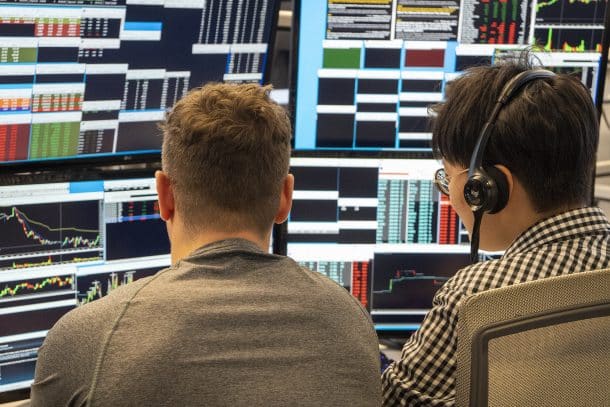As traders we want to believe for the most part we are making rationale trades from a risk to reward perspective. At SMB we ask ourselves “if I make this trade 1,000 times will there be a positive expectancy?” If the answer is yes then we make the trade. If the answer is no then we don’t make the trade. If we aren’t sure then we flip a coin 🙂
I was having a conversation a couple of months ago with one of our remote traders who had built up a fairly large position in NEI. He explained to me that the prior two times it had pulled back to 1.70 he had caught very nice bounces. I looked at the chart and offered the following comment: “technically doesn’t look good” (cool how gchat saves old conversations). Take a look at the chart I was looking at the time we spoke.
He said that he felt comfortable being long the stock and that he was willing to risk some money on the trade since he had made 9K in the stock on his previous trades. Was his thought process correct here? Should the fact that he had made thousands of dollars on previous trades in NEI had an impact on THIS trade?
I think there is a valuable trading lesson here. I know personally that I have allowed past profits in stocks I have traded impact my future trades in that stock. In 2007 RIMM was my most profitable stock. To this day I still feel more comfortable putting risk on in RIMM because of the money I made trading it when it moved from 40 to 140. But I think there is a distinction between feeling more comfortable putting on risk in a trade versus allowing past success to determine whether a trade itself offers favorable risk/reward.
I look forward to the feedback of our readers. I am sure many of you have some interesting thoughts to share on this topic.




8 Comments on “Spencer Asks: Are You Overvaluing Past Trading Successes?”
Finding comfort in a stock is like listening to a familiar song. It is rewarding, exciting, and maybe this time around you will hear something new. Fortunately, a song can not reverse on you. They have shown in studies regarding attachment theory that we exhibit different styles; one of those being “secure.” Reaping large rewards from one stock could potentially lead to this style of attachment. One of the key characteristics of this style is exploration. Which in my mind traders can regard as risk. This evolutionary benefit may hamper trading success.
Statistically speaking, your past trades and current trade quite often are independent events even if you are trading the same stock. As an intern, I haven’t even traded live, but I feel like your past P&L should not affect the amount of risk you should be willing to take at the present.
Statistically speaking, your past trades and current trade quite often are independent events even if you are trading the same stock. As an intern, I haven’t even traded live, but I feel like your past P&L should not affect the amount of risk you should be willing to take at the present.
What then should your decisions be based on if not your research backed up by actual p&l? This is actually the definition of trading with an edge. If the future does not match the past you don’t have an edge or any reason to be trading
I was mostly referring to Steve’s comment&questions: “He said that he felt comfortable being long the stock and that he was willing to risk some money on the trade since he had made 9K in the stock on his previous trades. Was his thought process correct here? Should the fact that he had made thousands of dollars on previous trades in NEI had an impact on THIS trade?”
Maybe I am wrong, but shouldn’t you apply the same strategy at the present no matter what your actual p&l was if you have the same information from the past? For example, if you decided not to trade a certain stock but recognized a clear trend that you could have made profit, shouldn’t you be able to use such info the next day equally?
A couple of thoughts:
There is a key difference between a technical intra-day setup(e.g. NEI above) AND RIMM’s macro weekly uptrend circa 2007.
I think the relative value one places on a past success is (or should be) determined by the alignment of the macro picture of the stock being aligned with a trade setup in your playbook whose performance is proven in that type of environment.
In the NEI play above the trader has had two successes (even the second trade is questionable IMO) and is attempting to enter a support play a third time @ $1.70. If you zoom out to a weekly view you can clearly see the significant selling in the week of 4/29/2011 as price failed to make a new high and formed a nasty double top reversal that traded straight down to support on high volume. In this case the playbook-setup was not aligned with the macro situation and the setup failed.
Assuming that a trader consistently trades with setups in alignment with macro trends then I think there is also a psychological factor to successful historic performance, a comfort level with a stock that will lend itself to unconsciously getting a great entry on a superior setup and taking large position size to big targets. The converse is also true, if you have consistently had poor results with a symbol, there is an underlying psychology that influences a trader to not get the great setup or entry and is likely to take profits to soon skewing the results poorly.
If you golf there is a good analogy here. All serious golfers are familiar with standing on the tee of a hole where you’ve had great historic success. You can’t wait to hit the ball. Your whole persona takes on a successful posture even before you address the ball giving you the highest probability of a successful outcome. Conversely stand on the tee of a hole that you’ve driven a box of ProVs OB and your inner caddie will tell you to pull out a wedge and try and hit the middle of the fairway just past the ladies tees. The hole has beat you before you even tee it up.
The great thing about trading is no one is forcing you to trade. You can play only the holes that you’re really good at.
Best,
-B
A couple of thoughts:
There is a key difference between a technical intra-day setup(e.g. NEI above) AND RIMM’s macro weekly uptrend circa 2007.
I think the relative value one places on a past success is (or should be) determined by the alignment of the macro picture of the stock being aligned with a trade setup in your playbook whose performance is proven in that type of environment.
In the NEI play above the trader has had two successes (even the second trade is questionable IMO) and is attempting to enter a support play a third time @ $1.70. If you zoom out to a weekly view you can clearly see the significant selling in the week of 4/29/2011 as price failed to make a new high and formed a nasty double top reversal that traded straight down to support on high volume. In this case the playbook-setup was not aligned with the macro situation and the setup failed.
Assuming that a trader consistently trades with setups in alignment with macro trends then I think there is also a psychological factor to successful historic performance, a comfort level with a stock that will lend itself to unconsciously getting a great entry on a superior setup and taking large position size to big targets. The converse is also true, if you have consistently had poor results with a symbol, there is an underlying psychology that influences a trader to not get the great setup or entry and is likely to take profits to soon skewing the results poorly.
If you golf there is a good analogy here. All serious golfers are familiar with standing on the tee of a hole where you’ve had great historic success. You can’t wait to hit the ball. Your whole persona takes on a successful posture even before you address the ball giving you the highest probability of a successful outcome. Conversely stand on the tee of a hole that you’ve driven a box of ProVs OB and your inner caddie will tell you to pull out a wedge and try and hit the middle of the fairway just past the ladies tees. The hole has beat you before you even tee it up.
The great thing about trading is no one is forcing you to trade. You can play only the holes that you’re really good at.
Best,
-B
I would here add something from Denise Shuul what I have in my trading journal:
Holy grail – is learning how to avoid having the feelings of one trade color the next.